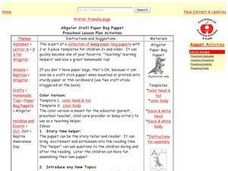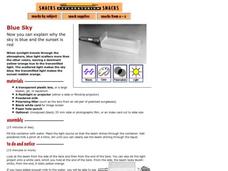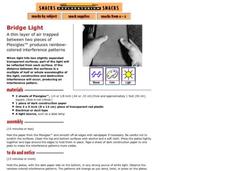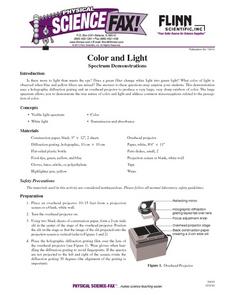Curated OER
Alligator Craft Paper Bag Puppet
Students make paper bag puppets. They use the puppets as a story teller and reader. Students use the puppets to ask questions during and after reading. They assemble their own puppet. Students use the puppets to introduce new themes,...
Curated OER
Tissue Paper Butterfly
Creating butterfly art is as simple as 1-2-3. Kids cut coffee filters into butterfly shapes. Next, they wet and place squares of tissue paper onto the filters. Fifteen minutes later, they lift the tissue to reveal a colorful pattern...
Curated OER
The Rain Game
It's raining, it's pouring! Simulate the precipitation process with rope or hula hoop and assorted colored construction paper. This simple game should give young students a better understanding of how rain falls.
Curated OER
Properties of Liquids
Students describe properties of liquids and use descriptive language as a springboard to develop precise vocabulary for properties of liquids. They also use vocabulary as practiced with liquid-vocabulary card games. Finally, students...
Curated OER
Summer
Students discover different uses of water. They discuss what lives in water and what does not. They match numbers 1-5 with objects of correct amount and recognize 5 different colors. They pick from pictures of different ways water...
Curated OER
Rocks Are Different Colors
Students examine different rocks and find the many different colors in each and then compare these rocks with other rocks. Then they look at their rock collection and tell me the colors they see. Students also put each rock in the bowl...
Curated OER
Hot and Cold Colors
Students explore the effect of heating and cooling on the dispersal of food coloring in water.
Exploratorium
Blue Sky
Use a container full of water as a prism and show that as light is bent, the individual colors from different wavelengths become visible. This explains why the sky appears to be blue midday, and why as the sun nears the horizon, it looks...
Curated OER
Electromagnetic Energy and Its Spectrum
Your older elementary students investigate electromagnetic energy and the electromagnetic spectrum. They will observe 7 items represented in the electromagnetic spectrum and make a poster of all the things the items have in common. After...
American Chemical Society
pH and Color Change
Did you know strong bases can feel slippery and slimy? Lesson allows scholars to practice using the pH scale to identify acids and bases and their strengths. By changing the concentration of an acid and a base, they create the entire...
Dick Blick Art Materials
No-Blender Pulp Painting
Like finger painting, this project is very tactile. Kids tear tissue paper into small pieces, add water, and mix up a pulp that can be pressed onto a canvas to create a colorful, textured painting.
Dick Blick Art Materials
Insoluble Paintings
Insolubility and density? Yup, it's art class, of course. To create insoluble paintings that continually move and change, kids mix water-based paint with mineral oil and seal the mixture in laminating pouches.
Curated OER
Colors of our Earth
Students are introduces to soil profile classification. They remember that classification of soils is an important aspect of studying soils as it aids in predicting how soils react to weathering, transport nutrients or pollution. ...
Exploratorium
Bridge Light
An illuminating activity demonstrates how interference of light waves creates a pattern. Using Plexiglas™ and construction paper, participants see rainbows appear as they twist or press against the plastic plates. After the activity, you...
Curated OER
Color and Light Spectrum Demonstrations
Students explore the light spectrum. The teacher uses holographic diffraction grafting film on an overhead to demonstrate the true nature of color. After observing a vivid rainbow, students recognize that white light is composed of all...
Curated OER
Radiation and Color
Tenth graders explore the relationship between color and heat absorption by measuring the temperature change of water in differently colored test tubes as they are exposed to a heat lamp. They work in small groups to collect data and...
Curated OER
Gel-O-Colors!!
What distinguishes the differences between refraction and reflection? Learners identify the properties of light as they mix colored light to create new color variations. As they work they gather data about the properties of light and...
American Chemical Society
The Density of Liquids
It's in your destiny to study density! Young scientists conduct an experiment to study the relationship between weight and density. They compare weights of liquid samples of different substances and predict how their densities are...
Curated OER
Here It Goes Again!
First graders work on patterns in nature and to recognize how different living things adapt to different environments such as the rain forest.
Curated OER
Freeze Pops
Learners experience problem-based learning as they use prior knowledge of the states of matter to keep a frozen juice bar from melting.
Curated OER
Melted Oceans Lesson Plan
Pupils use melted crayons to mix and blend into ocean in motion scenes. They choose colors that they see in ocean water, melt the crayons, and swirl the wax into designs on white construction paper. They finish the artwork by letting it...
Curated OER
The Art and Science of Impressionist Color
Discover Impressionist painting as learners investigate the 19th century combinations of colors characteristically used. Students experiment with their own paintings, utilizing primary and secondary colors.
Curated OER
Sunrise/Sunset
Third graders discovver what causes the dramatic colors of a sunset by seeing the changing color of light as it passes through a clear container of water to which milk is gradually added. They measure the liquids and observe what happens...
Curated OER
Light Week
First graders experiment with prisms to explore sequence of colors of light created.

























